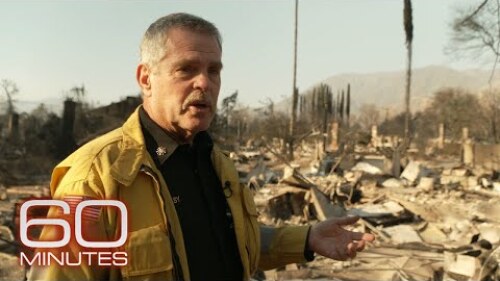There are fuel-driven wildfires where parched, contiguous vegetation powers a fire’s momentum. There are wind-driven wildfires where a steady air current provides the oxygen that fire craves, pushing the flame front willfully in the direction of the wind’s flow. And then there are Santa Ana wind-driven wildfires.
Also known as the Devil Winds, Santa Ana winds originate inland and blow downslope into Southern California’s valleys and basins, carrying no coastal moisture. They work like a hairdryer, pre-heating fuel already baked in the summer sun, just waiting for mother nature or human activity to create a spark that the winds will turn into a blowtorch, which will moonscape the land and anything or anyone in its path.
That it’s happening now, in the dead of winter, makes sense. It’s more common in autumn but still tracks here because the fuels had all year to dry, and winter hasn’t brought enough precipitation. So homes nestled in this bed of kindling called the wildland-urban interface (WUI) become one with the vegetation. The fire beast feeds on it but wants more and will travel where the Devil Winds carry it, even into the asphalted urban jungle, because there are combustibles wherever people live, and work and play.
The news is calling the fires burning in Los Angeles County “the worst ever.”
It is the worst ever for the 16 people who perished in this rash of conflagrations. It is the worst for their loved ones. It is the worst for the hundreds of thousands of evacuees who had to flee from their homes, many of which will be rubble when the evacuees return. It is the worst for pets who couldn’t escape with their owners. And it is the worst for firefighters.
I fought fires in California over the course of three decades. Winter wildfires were the most treacherous I’ve fought. It’s a mind game. How can the flame lengths be so high and jump so far when I can’t feel my toes because of the biting desert cold at night? And at lower elevations, nothing disheartens a firefighter more. It feels so empty to give everything you’ve got as the fire blazes past your efforts and consumes the next neighborhood.
And it is the worst for how strong and sustained these demon gusts are. I’ve battled in 70 mph winds but never 100. You can’t get in front of it. You’re fighting fire from behind, in its smoke and char-filled excrement, which makes it hard to breathe and harder still to dampen its momentum. That’s usually the job of aircraft. The tankers can drop hundreds or thousands of gallons of retardant to slow the spread and give ground troops a shot at full extinguishment. But wind reduces aerial operation effectiveness. And there are fewer large air tankers available now because contract pilots who dump retardant in the Western states have already migrated to Australia for its summer fires.
But these fires in Los Angeles are not the worst — not in terms of numbers. None of these fires will unseed the frontrunners on the lists for deadliest, most destructive or largest wildfires in California. Those fires already happened. Those fires were the warnings that this could happen and that this will happen again.
We are all bleeding on the inside, imagining how devastated we’d be if we were in Santa Ana’s crosshairs. And it’s all very raw. It might be too soon to call this out, but the president has issued the rally cry people want to hear: Extinguish the fire, rebuild, return to normalcy. But rebuilding in the footprint of fire these days almost always promises fire’s return. That’s normalcy in California. Just ask Malibu. So in the echo of the president’s cry, I can hear fire and wind laughing. It’s as if they have their own call to arms, “They say rebuild! We say reburn! They say rebuild! We say reburn!”
We’re starting to get better about doing all the things we need to do — hardening homes in the WUI, creating defensible space, having and following evacuation plans. It helps curb the loss, but when the Devil Winds rear, it’s not enough. We are watching the footage on the news right now. Once a spark catches in these conditions, fire is capable of levitating over pavement in search of our combustibles.
There are only two answers here. The first will not be palatable for property owners: Retreat, meaning, stop building in severe fire hazard areas. Consider finding a mantra other than “rebuild.” The second is more palatable but less feasible because fire prevention officials and their pal Smokey have been hard at it for over 80 years with waning success: Stop being careless.
Roughly 90% of wildfires in the United States are started by humans, and 80% of those are unintentional. We didn’t mean for it to happen. How could we have known? Fire needs only three things to burn: heat, fuel and oxygen. The WUI already has fuel and oxygen. The only thing we have to be careful about is introducing a heat source. But that’s too complicated. We don’t have time. We don’t have the RAM for it.
There was no reported lighting activity when the five fires started in Southern California. Mother nature brought the wind but not the spark. That leaves only us as the culprits. Until that changes, the worst is yet to come.




